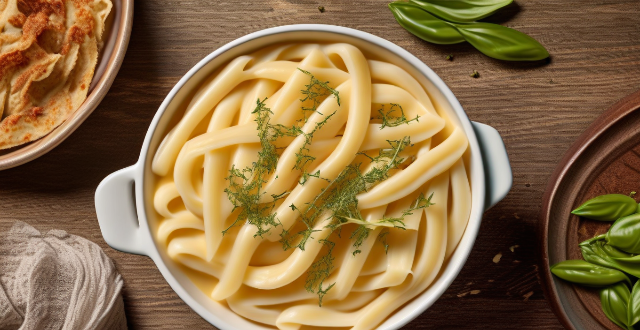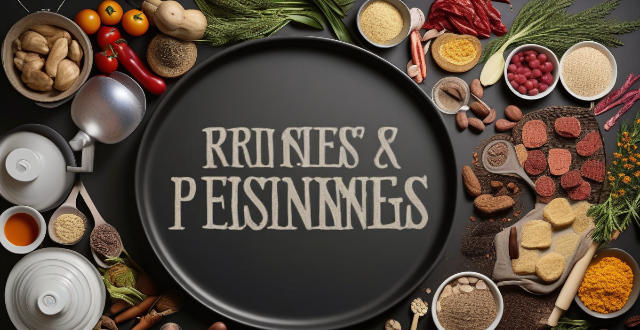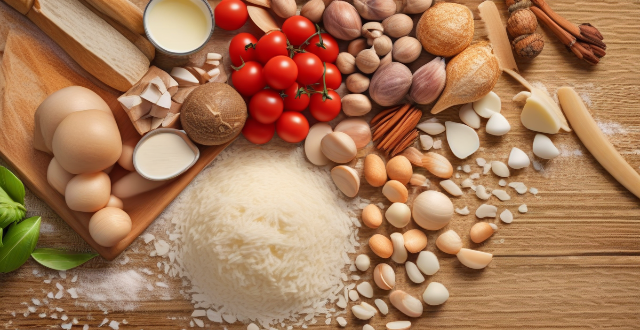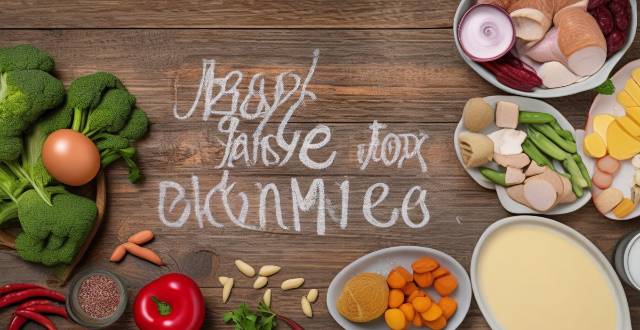Sauce
Sauce Pasta Sauce Vegetable Sauce Pesto Sauce Pepper Sauce Based Sauce Include Sauce Chicken Sauce Salad Sauce Ingredient Sauce Salt Sauce Basil Sauce Recipe Sauce Optional Sauce Quality Sauce Cheese Sauce Flavor Sauce Creamy Sauce Mustard Sauce Nuts Sauce Cake Sauce Protein Sauce Dairy Sauce Crab Sauce Parmesan
How do I make a creamy pasta sauce without using heavy cream ?
To make a creamy pasta sauce without using heavy cream, start by sautéing aromatics like onions and garlic in olive oil. Then, add vegetable or chicken broth and unsweetened non-dairy milk to the pan. Thicken the mixture with a flour slurry and season it with Dijon mustard, salt, and pepper. Finally, toss the creamy sauce with your cooked pasta for a delicious dairy-free meal.

Can you recommend a classic Italian pasta sauce that's not tomato-based ?
Certainly! If you're looking for a classic Italian pasta sauce that isn't tomato-based, one excellent choice is the Pesto Sauce. Here's a closer look at this delicious sauce: ### Ingredients: - Fresh basil leaves - Garlic - Pine nuts - Parmesan or Pecorino cheese - Extra virgin olive oil - Salt ### Preparation: 1. Gather all the ingredients to make a perfect batch of pesto. 2. Toast the pine nuts in a dry pan to enhance their flavor. 3. Blend the basil, garlic, toasted pine nuts, grated cheese, and extra virgin olive oil in a food processor until well blended but still slightly chunky. 4. Season with salt and possibly some pepper. 5. Mix the pesto with cooked pasta, adding some reserved cooking water if needed. ### Tips: - Use fresh basil for the best flavor. - Choose a good-quality extra virgin olive oil. - Adjust the cheese and garlic quantity based on personal preference. ### Variations: - For a Pesto alla Trapanese variation, use almonds instead of pine nuts, add tomatoes, and sometimes mint along with the basil. - Try different types of nuts such as walnuts for a Walnut Pesto. Pesto is not only versatile but also easy to prepare. It's a vibrant green sauce that's full of flavor, making it a perfect alternative to tomato-based sauces. Enjoy your pesto with pasta or use it in other dishes like sandwiches or as a dip.

What are some healthy Italian pasta dishes ?
Italian cuisine is known for its delicious pasta dishes, but not all of them are healthy. Here are some healthier options that you can try: 1. Whole Wheat Pasta with Tomato Sauce 2. Zucchini Noodles with Pesto 3. Spaghetti Squash with Marinara Sauce 4. Pasta Primavera 5. Grilled Vegetable Pasta Salad 6. Mushroom Stroganoff 7. Seafood Pasta 8. Caprese Pasta Salad 9. Eggplant Parmesan 10. Vegetable Lasagna

Can you suggest a quick and easy pasta recipe for busy weeknights ?
This quick and easy pasta recipe is perfect for busy weeknights. It requires minimal ingredients like spaghetti pasta, tomato sauce, onion, garlic, olive oil, salt, pepper, and optional grated Parmesan cheese. The steps involve cooking the pasta, sautéing onions and garlic, adding tomato sauce, mixing the pasta with the sauce, and serving with optional Parmesan cheese. This recipe can be customized with add-ins like vegetables, meatballs, or chicken.

What are some simple and quick meal ideas for busy weeknights ?
When time is limited, it's essential to have a few go-to meal ideas that are both quick and easy to prepare. Here are some simple and delicious options for busy weeknights: Stir-Fry: A stir-fry is a versatile and customizable option that comes together quickly. Ingredients include protein of choice (chicken, beef, tofu, shrimp), mixed vegetables (bell peppers, broccoli, carrots, onions), and stir-fry sauce or seasonings (soy sauce, garlic, ginger). Pasta with Pesto or Marinara: Pasta dishes are classic fast options that don't require much effort. Ingredients include pasta of choice, premade pesto or marinara sauce, and optional add-ins (grilled chicken, cherry tomatoes, spinach). Quinoa Bowl: Quinoa bowls are a healthy and filling meal that can be customized with various toppings. Ingredients include quinoa, vegetables (roasted sweet potatoes, avocado, roasted Brussels sprouts), protein (chickpeas, grilled chicken, hard-boiled eggs), and dressing (lemon vinaigrette, tahini sauce). Sheet Pan Dinner: Sheet pan dinners are an all-in-one meal that requires minimal cleanup. Ingredients include protein (chicken thighs, salmon fillets), root vegetables (potatoes, carrots, parsnips), and seasonings (olive oil, salt, pepper, herbs). Sandwiches or Wraps: Sandwiches and wraps are portable and can be made ahead for lunches or quick dinners. Ingredients include bread or wraps, protein (deli meat, tuna salad, hummus), vegetables (lettuce, tomato, cucumber, onion), and condiments (mayonnaise, mustard, pesto).

How do I get that restaurant-quality flavor in my homemade crab cakes ?
How to Achieve Restaurant-Quality Flavor in Homemade Crab Cakes: - Freshness and quality of ingredients are crucial. - Lump crabmeat is preferred for its sweet flavor and good texture. - Use a combination of seasonings like Old Bay, mustard, Worcestershire sauce, and hot sauce. - Bind the mixture with mayonnaise or mustard lightly. - Pan-fry or oven-bake the crab cakes for different textures. - Serve with remoulade sauce and sides like green salad or roasted vegetables. - Allow the crab cakes to rest before cooking and avoid overcrowding the pan.

What are some creative ways to use tofu in vegetarian cooking ?
Tofu is a versatile and nutritious ingredient that can be used in a variety of vegetarian dishes. Here are some creative ways to use tofu in your cooking: marinated and grilled tofu skewers, creamy tofu pasta sauce, tofu stir-fry, tofu bao buns, tofu scramble, and tofu dumplings. By incorporating these ideas into your vegetarian cooking, you can enjoy the many health benefits of tofu while exploring new flavors and textures in your meals.

What are the best budget-friendly family meals ?
When it comes to feeding a family on a budget, there are plenty of delicious and nutritious meal options that won't break the bank. Here are some of the best budget-friendly family meals: 1. Spaghetti with Meat Sauce 2. Chicken Stir Fry 3. Baked Potatoes with Toppings 4. Tacos 5. Roasted Vegetables and Quinoa Salad

What are some healthy and low-calorie recipes for weight loss ?
Weight loss is a common goal for many people, but it can be difficult to find healthy and low-calorie recipes that taste good. Here are some healthy and low-calorie recipes that you can try: 1. Roasted Brussels Sprouts with Garlic and Parmesan Cheese: This recipe involves trimming and halving 2 cups of Brussels sprouts, mincing 3 cloves of garlic, and combining them with olive oil, salt, pepper, and grated Parmesan cheese before roasting in the oven. 2. Baked Salmon with Lemon and Dill Sauce: This recipe involves placing skinless salmon fillets on a baking sheet and whisking together lemon juice, dill weed, salt, pepper, olive oil, white wine vinegar, honey, and water before pouring over the fish and baking in the oven. 3. Zucchini Noodles with Pesto Sauce: This recipe involves spiralizing or cutting zucchini into noodles using a spiralizer, cooking them in olive oil until softened, adding pesto sauce, salt, pepper, chopped parsley leaves, and freshly grated Parmesan cheese if desired before serving warm.

How can I recreate my favorite restaurant's pasta dish at home ?
Recreating your favorite restaurant's pasta dish at home can be a fun and rewarding experience. Here are some steps to help you achieve that delicious taste in your own kitchen: 1. Gather all the necessary ingredients, including pasta, sauce, proteins, vegetables, cheese, herbs, and spices. 2. Make sure you have all the necessary tools for cooking and serving the dish, such as a large pot, colander, frying pan or skillet, wooden spoon or spatula, grater, and pasta server. 3. Follow these steps to recreate your favorite restaurant's pasta dish: boil the pasta, cook the protein, sauté the vegetables, make the sauce, combine everything, add cheese and herbs, serve hot with additional toppings or side dishes if desired. 4. Enjoy your homemade pasta dish with your family or friends!

What are some vegetarian Italian pasta recipes ?
Italian cuisine is known for its delicious pasta dishes, and there are plenty of vegetarian options to choose from. Here are some vegetarian Italian pasta recipes that you can try: 1. Spaghetti with Tomato Sauce 2. Mushroom Stroganoff 3. Pesto Pasta 4. Roasted Vegetable Pasta 5. Creamy Spinach Pasta

What's the secret to making crispy fried calamari ?
Fried calamari is a popular dish in many cuisines, and achieving that perfect crispy texture can be a challenge. Here's a step-by-step guide on how to make crispy fried calamari: Ingredients: Calamari rings, Flour, Salt, Black Pepper, Garlic Powder, Paprika, Lemon Juice, Vegetable Oil for frying. Steps: Clean the calamari thoroughly under running water. Remove the heads and innards from the tubes. Cut the tubes into rings about ½ inch wide. In a large bowl, mix together flour, salt, black pepper, garlic powder, paprika, and lemon juice to form a batter. Add the calamari rings to the bowl and coat them evenly with the batter. Let the calamari marinate in the mixture for at least 30 minutes. Heat vegetable oil in a deep fryer or large pan over medium-high heat. Once the oil is hot, carefully add the calamari rings to the fryer or pan. Fry the calamari until they are golden brown and crispy, stirring occasionally to prevent sticking. Use a slotted spoon to remove the fried calamari from the oil and place them on a paper towel-lined plate to drain excess oil. Serve the crispy fried calamari hot with your favorite dipping sauce. Some popular options include marinara sauce, tartar sauce, or aioli.

How do I make authentic spaghetti carbonara ?
Spaghetti Carbonara: A Guide to Making an Authentic Italian Dish Spaghetti Carbonara is a classic Italian dish known for its simplicity and rich flavors. Here's a step-by-step guide on how to make an authentic Spaghetti Carbonara: **Ingredients Needed:** - **Pasta:** 1 pound spaghetti - **Cheese:** 1 cup grated Pecorino Romano cheese (or a mix of Pecorino and Parmesan) - **Meat:** 1/2 cup diced pancetta or guanciale - **Garlic:** 4 cloves, minced - **Eggs:** 3 large - **Seasoning:** Freshly ground black pepper and salt - **Fat:** 1 tablespoon olive oil and 1 tablespoon butter **Cooking Process:** 1. **Preparation:** Gather all ingredients before starting. 2. **Cook the Pasta:** Boil spaghetti in salted water until al dente, reserving some pasta water before draining. 3. **Cook Pancetta/Guanciale:** Heat olive oil, cook the meat until crispy, then remove from skillet. 4. **Add Garlic:** Cook garlic in the rendered fat without burning. 5. **Beat Eggs:** In a bowl, beat eggs with a pinch of salt. 6. **Combine Ingredients:** Toss cooked spaghetti in the skillet with the rendered fat. Remove from heat and let cool slightly. 7. **Add Egg Mixture and Cheese:** Pour egg mixture over spaghetti, quickly tossing to combine. Add grated cheese gradually while tossing to create a creamy sauce. Use reserved pasta water if needed. 8. **Add Meat and Season:** Return the cooked pancetta or guanciale to the skillet, season generously with black pepper, and adjust salt. 9. **Serve:** Serve immediately, garnished with additional cheese and black pepper. **Tips for Perfection:** - Ensure egg safety by using a hot skillet to gently cook them into a sauce. - Use Pecorino Romano or a mix with Parmesan for authenticity; avoid pre-grated cheeses. - Reserve pasta water for sauce consistency adjustments. By following these steps and tips, you can enjoy a delicious and authentic Spaghetti Carbonara at home.

How do I properly season my stir-fry dishes ?
When it comes to stir-fry dishes, seasoning is key to achieving that perfect balance of flavors. Here are some tips on how to properly season your stir-fry dishes: 1. Choose the right ingredients: Select fresh vegetables and proteins that will complement each other in terms of flavor and texture. 2. Use a variety of sauces and spices: Experiment with different sauces and spices to find the perfect combination for your dish. 3. Balance sweet, sour, salty, and spicy flavors: A good stir-fry should have a balance of these four flavors. 4. Cook in batches and use high heat: Cook your ingredients in batches over high heat to ensure even cooking and maximum flavor. 5. Taste and adjust as needed: Taste your stir-fry as you go and adjust the seasoning as needed.

What are some creative dinner recipes that use leftover chicken or turkey ?
Using leftover chicken or turkey is a great way to save time and money while still enjoying delicious and creative meals. Here are some recipe ideas that will help you transform your leftover poultry into something new and exciting. Chicken or Turkey Salad Sandwiches: Toss the shredded chicken or turkey with your favorite dressing, then assemble the sandwich by layering mixed greens, tomatoes, red onion, and the dressed chicken or turkey on whole grain bread. Enjoy as a light lunch or dinner option. Chicken or Turkey Stir-Fry: Heat oil in a wok or large skillet over medium-high heat, add garlic and ginger, stirring quickly until fragrant. Add vegetables and cook until they begin to soften. Add cubed chicken or turkey and continue to stir-fry. Season with soy sauce and serve over rice or noodles for a complete meal. Chicken or Turkey Enchiladas: Preheat oven to 350°F (175°C). Warm tortillas in the oven or microwave until pliable. Combine shredded chicken or turkey with cheese, onions, and black beans if desired. Spoon the mixture onto each tortilla and roll tightly. Place enchiladas in a baking dish and cover with enchilada sauce. Top with additional cheese and bake for 20-25 minutes until heated through and cheese is melted. Serve with salsa and enjoy!

What makes street food unique in different parts of China ?
Street food in China reflects the country's diverse cultural heritage and regional differences. From hearty meals in the north to seafood delights in the south, each region offers its own unique flavors and dishes. The cuisine of eastern China is influenced by its coastal location and the use of soy sauce, while western China's mountainous terrain and ethnic diversity are reflected in the variety of street foods available. Regardless of where you go in China, you're sure to find something delicious to try!

What are some popular Japanese dishes ?
Japanese cuisine is known for its exquisite flavors, meticulous preparation, and beautiful presentation. Some popular dishes include sushi, ramen, tempura, udon, and okonomiyaki. Sushi comes in various forms such as nigiri, sashimi, and maki. Ramen is a noodle soup with different broths and toppings. Tempura is a fried dish with a light batter. Udon is thick noodles served hot or cold with various toppings. Okonomiyaki is a savory pancake with diverse ingredients. Each region in Japan has its own specialties and unique flavors to explore.

Can you explain the concept of umami in Japanese cooking ?
Umami is one of the five basic tastes, along with sweet, sour, salty, and bitter. It is often described as a savory or meaty taste, and is commonly found in foods such as mushrooms, soy sauce, and aged cheeses. In Japanese cooking, umami is considered an essential flavor profile that adds depth and complexity to dishes. The science of umami is caused by the presence of glutamate, a type of amino acid, in food. When we eat foods that contain glutamate, it stimulates our taste buds and sends signals to our brain that register as a distinct taste. This taste is often associated with protein-rich foods like meat, fish, and vegetables. In Japanese cuisine, umami is used to enhance the flavors of dishes and create a more complex taste profile. Some common ingredients that are high in umami include miso (fermented soybean paste), dashi (Japanese broth made from dried fish and seaweed), soy sauce, dried shiitake mushrooms, and kombu (a type of seaweed). Umami is used in a variety of ways in Japanese cooking. For example, miso soup is made by mixing miso paste with dashi broth to create a savory soup that is often served as part of a traditional Japanese breakfast. Sushi combines vinegared rice, fresh fish, and soy sauce to create a perfect balance of flavors that includes umami. Ramen noodles use a broth made with chicken or pork bones, which are rich in umami. Teppanyaki involves grilling meat and vegetables on a hot plate, which helps to release their natural umami flavors. In conclusion, umami is an important flavor profile in Japanese cooking that adds depth and complexity to dishes. By using ingredients that are high in glutamate, chefs can create dishes that are both delicious and satisfying.

What are some good options for quick and easy vegetarian meals ?
Vegetarian meals can be quick and easy to prepare. Here are some options: stir-fry vegetables with rice or noodles, quinoa salad with roasted vegetables, vegetable soup or broth, veggie burgers with avocado and salsa, and pasta with pesto and cherry tomatoes. These meals can be customized based on preferences and what's available in the kitchen.

What are some quick and easy recipes for beginners ?
The text provides quick and easy recipes for beginners, including Spaghetti with Tomato Sauce, Grilled Cheese Sandwich, and Omelette. These dishes require minimal ingredients and effort, making them perfect for those new to cooking. The instructions are straightforward and easy to follow, allowing anyone to create delicious meals at home.

What kind of ingredients are commonly used in Japanese cuisine ?
Japanese cuisine is known for its unique flavors, fresh ingredients, and beautiful presentation. The most commonly used ingredients in Japanese cooking include white rice, brown rice, sweet rice, tuna, salmon, squid, shellfish, chicken, beef, pork, cabbage, eggplant, green onions, mushrooms, soy sauce, miso, udon noodles, soba noodles, ramen noodles, rice vinegar, sesame oil, nori, wasabi, and pickled ginger. These ingredients combine to create the diverse and delicious flavors that make Japanese cuisine so beloved around the world.

What are the most popular street foods in different countries ?
Street food is a significant aspect of many cultures worldwide, offering diverse flavors and culinary experiences. Here are some of the most popular street foods from different countries: 1. United States: Hot Dogs, Pretzels, Nachos 2. Mexico: Tacos, Elote, Churros 3. Japan: Takoyaki, Okonomiyaki, Yakitori 4. India: Samosas, Pani Puri, Vada Pav 5. Thailand: Pad Thai, Mango Sticky Rice, Som Tam 6. Italy: Pizza al Taglio, Supplì, Gelato 7. China: Jianbing, Baozi, Roujiamo 8. Turkey: Midye Dolma, Simit, Baklava 9. Vietnam: Banh Mi, Bun Cha, Pho 10. Egypt: Falafel, Koshari, Shawarma

What are some easy and delicious recipes for a family dinner ?
The text provides three easy and delicious recipes for a family dinner: Spaghetti Carbonara, Chicken Stir Fry, and Baked Salmon with Lemon and Herbs. Each recipe includes a list of ingredients and step-by-step instructions for preparation and cooking. The Spaghetti Carbonara recipe involves cooking spaghetti and bacon, making a sauce with heavy cream and Parmesan cheese, and serving it hot with crumbled bacon on top. The Chicken Stir Fry recipe requires stir frying chicken strips, vegetables, and seasonings in a wok or skillet and serving it hot with rice or noodles. The Baked Salmon with Lemon and Herbs recipe involves baking salmon fillets with lemon slices and herbs until cooked through and flaky.

What kind of seasonings work well with different types of fish ?
This text provides a comprehensive guide to seasonings for various types of fish and shellfish, categorized by freshwater and saltwater species. It offers specific seasoning suggestions for each type of fish or shellfish, such as salmon, trout, catfish, tuna, mahi-mahi, sardines, anchovies, shrimp, lobster, crab, clams, mussels, and oysters. The suggested seasonings aim to enhance the natural flavors of the seafood while adding depth and complexity to the dishes.

Can you suggest some quick and easy dinner recipes for busy weeknights ?
When you're short on time but still want to enjoy a delicious and satisfying dinner, these quick and easy recipes are perfect for busy weeknights. They require minimal preparation and cooking time, making them ideal for those days when you just don't have the energy to spend hours in the kitchen. Here are some of our favorite options: Grilled Cheese Sandwiches: Grilled cheese sandwiches are a classic comfort food that can be made in just minutes. Simply butter two slices of bread, place a slice of cheese between them, and grill until golden brown and melted. You can also add toppings like sliced tomato, bacon, or avocado for extra flavor. Pasta with Tomato Sauce: Pasta with tomato sauce is another quick and easy option that comes together in just 20 minutes. Cook your favorite pasta according to package instructions, then sauté chopped onions and garlic in olive oil until softened. Add a can of crushed tomatoes and let simmer for a few minutes before tossing with the cooked pasta. Garnish with fresh basil and Parmesan cheese if desired. Stir-Fry Vegetables: Stir-fry vegetables are a great way to use up any leftover veggies you have on hand. Simply chop your vegetables into bite-sized pieces and sauté them in a hot wok or skillet with some oil and your favorite seasonings (such as soy sauce, ginger, or garlic). Serve over rice or noodles for a complete meal. Quesadillas: Quesadillas are an easy and versatile dinner option that can be customized to suit your tastes. Simply fill a tortilla with shredded cheese, diced vegetables, and/or cooked protein like chicken or beef. Fold the tortilla in half and cook in a skillet until the cheese is melted and the tortilla is crispy. Serve with salsa, sour cream, or guacamole for dipping. Roasted Vegetables: Roasting vegetables is an easy way to add flavor and nutrition to any meal. Simply chop your favorite vegetables (such as broccoli, cauliflower, carrots, or sweet potatoes) into bite-sized pieces and toss with olive oil, salt, and pepper. Roast in a preheated oven at 400°F for 20-30 minutes, or until tender and caramelized. Serve alongside grilled chicken or fish for a complete meal.

What is the difference between ramen and udon noodles ?
Ramen and udon are two popular Japanese noodle dishes with unique flavors, textures, and cultural significance. Ramen is made from wheat flour, water, salt, and kansui, resulting in elastic and chewy noodles. It is typically served in a meat-based broth flavored with soy sauce, miso, or seafood, and topped with pork, menma, scallions, nori, and a soft-boiled egg. Udon, on the other hand, is made primarily from wheat flour and water, producing thicker and smoother noodles. Its broth is usually clear and light, made from kombu and shiitake mushrooms, and often served hot or cold with simple toppings like tempura, green onions, or grated ginger. Ramen originated in China but became popular in Japan during the early 20th century, evolving into a staple of Japanese cuisine. It has numerous regional variations across Japan, such as Sapporo's miso ramen, Hakata's tonkotsu ramen, and Tokyo's soy sauce-based ramen. Ramen shops can be found everywhere in Japan, from high-end establishments to quick street food stalls, reflecting its deep integration into daily life. Udon has been part of Japanese cuisine for centuries and is traditionally associated with Sanuki (now Kagawa Prefecture), known as the "Udon Kingdom." While udon is typically served in a simple broth or chilled with a dipping sauce, there are also hot pot variations like nabe and kitsune (fox) udon. Udon is often considered comfort food in Japan and is frequently consumed during cold weather or as a quick meal due to its ease of preparation. In conclusion, ramen and udon offer distinct experiences for those who enjoy them. Ramen provides a hearty and filling meal with complex broths and diverse toppings, while udon offers a cleaner taste with simpler broths and toppings, focusing on the pure enjoyment of the noodle itself. Both have their place in Japanese cuisine and continue to captivate noodle enthusiasts around the world.

What are the best Italian pasta recipes for beginners ?
The provided text offers two Italian pasta recipes suitable for beginners: Spaghetti Carbonara and Penne all'Arrabbiata. The first recipe includes ingredients like spaghetti, bacon, garlic, Parmesan cheese, and egg yolks, and involves cooking the spaghetti, making a bacon-garlic mixture, and combining everything with a cheese-egg yolk mixture. The second recipe calls for penne pasta, olive oil, garlic, red pepper flakes, crushed tomatoes, salt, pepper, and basil leaves, and consists of cooking the penne, preparing a spicy tomato sauce, and combining them. Both dishes are described as easy to prepare and full of flavor.

What are some unique and delicious New Year's Eve snacks ?
New Year's Eve is a time for celebration and indulgence, and what better way to celebrate than with some unique and delicious snacks? Here are five ideas to get you started: 1. Fruit and Cheese Platter - Fresh fruits such as grapes, apples, and pears, assorted cheeses like Brie, Cheddar, and Gouda, crackers or bread for pairing. 2. Baked Brie En Croute - Wheel of Brie cheese, puff pastry sheet, egg wash (egg beaten with a bit of water), jam or preserves (optional). 3. Charcuterie Board - Assorted cured meats like salami, prosciutto, and chorizo, assorted olives and pickled vegetables, crackers or bread for pairing, mustard, hummus or other dips. 4. Shrimp Cocktail - Cooked shrimp, peeled and deveined, cocktail sauce or homemade dipping sauce, lemon wedges for garnish. 5. Chocolate Fondues - Assorted chocolate bars (milk, dark, white), assorted dippers like strawberries, marshmallows, and pretzels.

Can you suggest some healthy seafood recipes ?
Seafood is a nutritious and delicious source of protein and omega-3 fatty acids. Here are three healthy seafood recipes you can try at home: grilled salmon with lemon and herbs, baked cod with roasted vegetables, and shrimp stir fry with broccoli and snow peas. These recipes are easy to make and packed with flavor and nutrients. Enjoy!